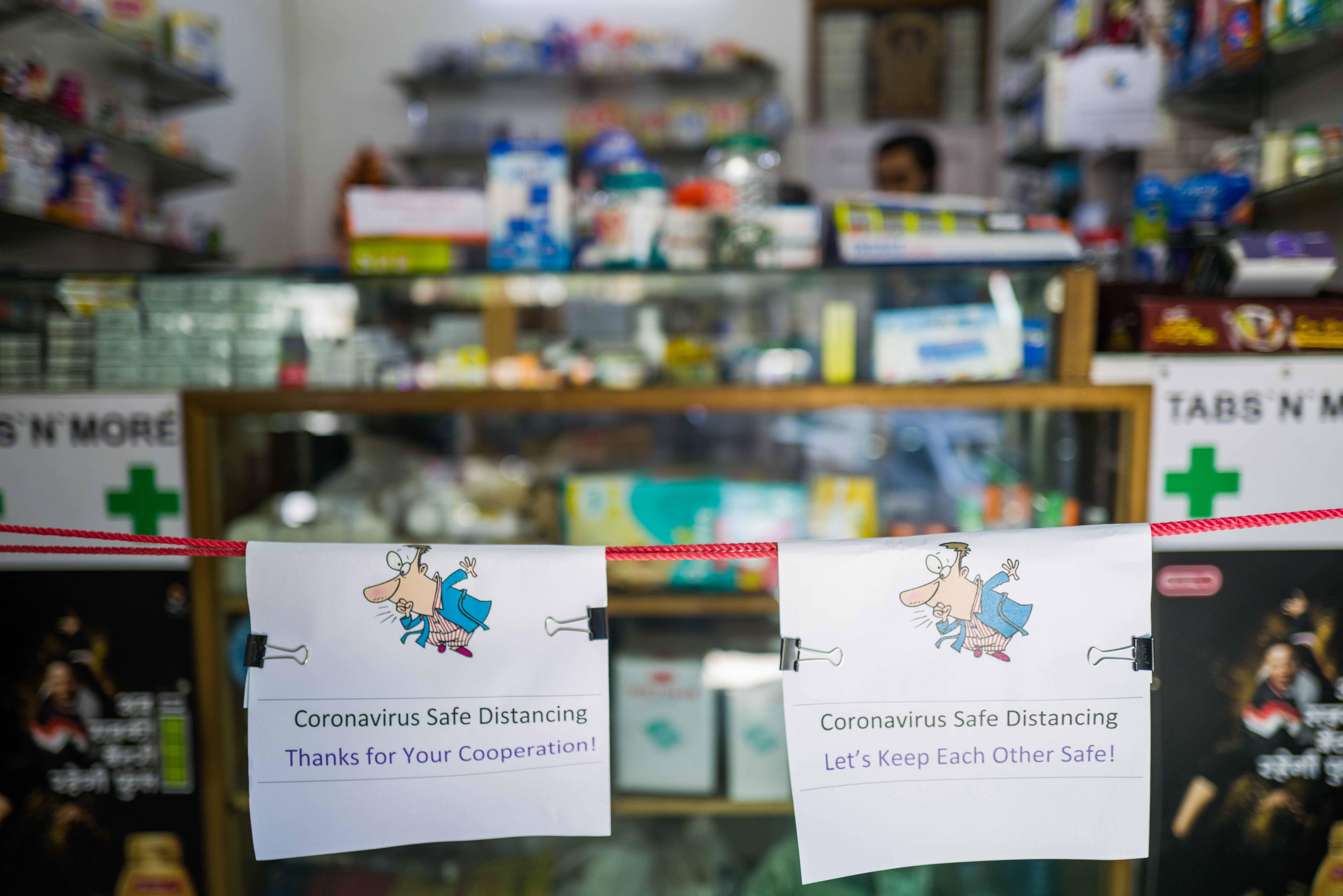India to reduce reliance on Chinese drugs as border tensions rise

An employee (back) stands behind the counter and a rope barrier for ‘safe distance’ from customers as a preventive measure against the COVID-19 coronavirus in a pharmaceutical store in New Delhi on March 18, 2020. Photo by Jewel SAMAD / AFP
BANGALORE — With border tensions rising, India is trying to reduce its significant dependency on China for pharmaceutical raw materials.
The Indian pharmaceutical industry is the third largest in the world by production and fourteenth by value. Its low-cost and quality generic drug formulations have helped millions with HIV and cancer around the world.
But India relies heavily on imports of various raw materials, specifically Active Pharmaceutical Ingredients (APIs), which give a drug its therapeutic effect; key starting materials (KSMs), which are crucial reactants in the drug; and intermediates, which are drugs used as raw materials to produce bulk drugs.
These raw materials accounted for over half of pharmaceutical imports in 2019. About 70 per cent were from China, largely due to lower costs.
India has long wanted to change this situation, and in 2015, the government set up a committee to recommend ways to be more self-sufficient.
Article continues after this advertisement“There was no focus for two-three years, but in the past year, and especially after the Doklam standoff” – when Bhutan and India opposed Chinese construction of a road near the India-China-Bhutan border – “the government realized that it wanted to develop our capabilities in APIs, starter materials and intermediates,” said Mr Udaya Bhaskar, director general of the Pharmaceuticals Export Promotion Council of India (Pharmexcil), set up by the Ministry of Commerce and Industry.
Article continues after this advertisementRecent events have only increased the urgency.
The global and domestic lockdowns to battle the coronavirus pandemic brought import of raw materials from China to a halt for over two months and was restored only recently.
Bulk drug prices also increased. For instance, from January to April, the prices per kilo of azithromycin, hydroxychloroquine (HCQ) and Oseltamivir increased from 7,200 to 16,000 rupees ($132 to $293); 7,800 to 75,000 rupees; and 100,000 to 170,000 rupees respectively.
“The APIs (also called bulk drugs) used in our formulations, particularly in essential medicines, are from China. We realized this is not sustainable,” said Mr Ashok Madan, executive director of the Indian Drug Manufacturer’s Association.
On June 2, after extensive discussions with pharmaceutical manufacturers, the Indian government sanctioned two schemes to boost local manufacturing and sustainable domestic supply of critical bulk drugs.
The department of pharmaceuticals offered grants for states to build three bulk drug parks at 10 billion rupees each in five years.
The government has also sanctioned 69.40 billion rupees as production incentives for makers of 53 critical bulk drugs (26 fermentation-based and 27 chemical synthesis-based drugs) for eight years.
There might not be much time, however.
Since the June 16 clashes in the Galwan valley between Chinese and Indian troops that saw 20 Indian soldiers die, trade relations between the two Asian giants might now be on shaky ground.
The pharma industry is now strategizing faster steps towards self-reliance.
“Setting up fermentation-based production capabilities will take two to three years because it is capital intensive, but the 27 synthetic chemicals are a low hanging fruit. Our existing API units can start making them fast with some financial handholding and technical support from the government,” said Mr Madan.
India used to produce much of its own penicillin and other raw materials till the 1990s, after which it shifted focus to formulations that had higher profit margins.
“China’s advantage a decade ago was economic, but higher material costs, ethical business practices and pollution mitigation rules may mean that the price differential isn’t much anymore.
“India already has the technology and today, could have a price edge too,” said Pharmexil’s Mr Bhaskar.
China is the world’s factory for penicillin, antibiotics and pain medicines, as well as surgical masks and medical devices.
The Covid-19 crisis has led many countries like the United States – which gets 90 per cent of its antibiotics, Vitamin C and ibuprofen from China – and India to believe that the vulnerability could leave them short of medicines during a war, trade conflict or pandemic.
“Indian pharma increasing its domestic production of raw materials is a positive development for the whole world,” added Mr Bhaskar.